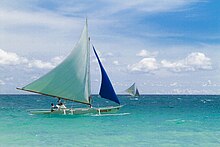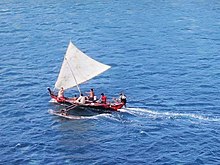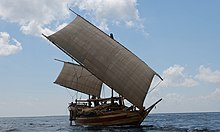Salisipan

Salisipan are long and narrow war canoes, with or without outriggers, of the Iranun and Banguingui people of the Philippines. They were mainly used for piracy and for raids on coastal areas. Salisipan resemble a long and narrow bangka that sit low on the water. They are propelled by rowers, steered by an oar at the stern, and are light enough to be hauled ashore. They are typically equipped with woven shields of nipa that could be propped along the sides to protect the rowers against arrows. They are sometimes also known by the more general terms vinta, baroto, or kakap.[1]: 239 [2][3] Salisipan are auxiliary vessels that accompany larger motherships like pangajava, garay, and lanong. Their presence was usually indicative of a larger raiding fleet nearby.[4][5]: 239–241
See also
[edit]References
[edit]- ^ Warren, James Francis (2007). The Sulu Zone, 1768-1898: The Dynamics of External Trade, Slavery, and Ethnicity in the Transformation of a Southeast Asian Maritime State. NUS Press. ISBN 9789971693862.
- ^ "Salisipan". Diccionario de la lengua española. Real Academia Española. Retrieved 30 October 2019.
- ^ Javellana, René B. (1997). Fortress of Empire: Spanish Colonial Fortifications of the Philippines, 1565-1898. Bookmark. p. 85. ISBN 9789715691994.
- ^ Warren, James Francis (1987). At the Edge of Southeast Asian History: Essays. New Day Publishers. pp. 45–46. ISBN 9789711002633.
- ^ Warren, James Francis (2002). Iranun and Balangingi: Globalization, Maritime Raiding and the Birth of Ethnicity. NUS Press. ISBN 9789971692421.





